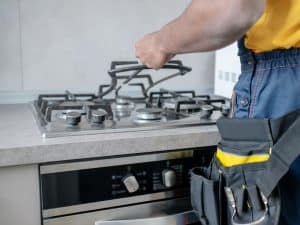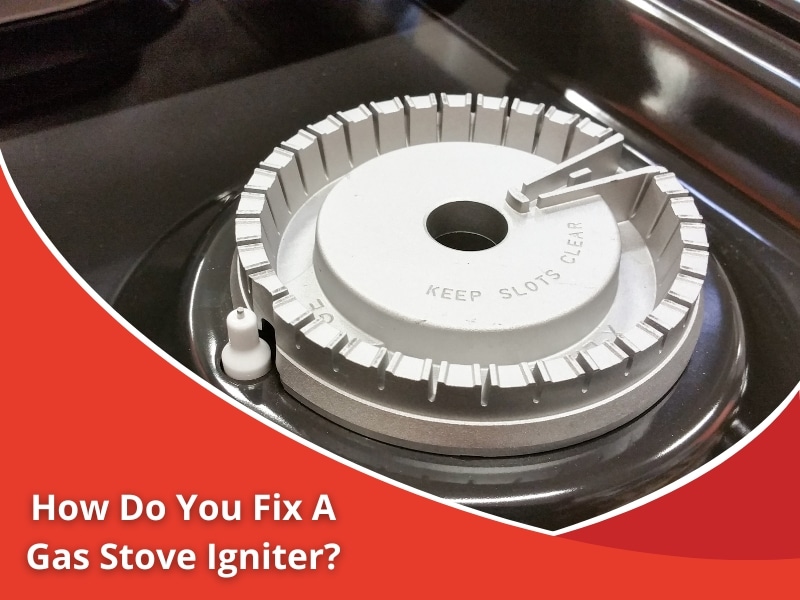Your gas stove igniter is crucial to your kitchen’s functionality. When it stops working, cooking can become an ordeal. While some issues with the igniter may require professional assistance, there are troubleshooting and repair steps you can handle yourself. This guide will walk you through identifying the problem, how to fix a gas stove igniter, and when to call in the experts.
What are the common signs of a faulty gas stove igniter you should watch out for?
Before attempting to fix your gas stove igniter, it’s essential to recognise the warning signs. Knowing these can help you identify the problem early and avoid more significant issues.
- There is no clicking sound when you try to light the burner.
- Gas odour without ignition can be a sign the igniter isn’t sparking.
- Weak or inconsistent sparks coming from the igniter.
- Delayed ignition, where the gas takes a while to ignite after you turn the burner on.
- One burner works, but others don’t, suggesting an isolated issue with a particular igniter.
These are the most common symptoms of a faulty igniter. If you notice any of these, let’s take a closer look.
How can you troubleshoot a gas stove igniter?
Before jumping into repairs, start by troubleshooting the igniter to determine the root cause of the problem.
- Inspect the igniter visually. Look for dirt, grime, or food debris obstructing it. If needed, clean the igniter with a brush.
- Check the connections. Loose or disconnected wires might cause the igniter to stop working. Secure any loose wires.
- Test the igniter spark. Turn on the stove and observe the spark. The igniter may need cleaning or replacement if it’s weak or nonexistent.
- Verify the gas supply and ensure the gas flows appropriately to the stove. A disruption in gas flow could affect the igniter’s performance.
- Listen for the click. If there’s no clicking sound, the igniter might not be getting power or completely dead.
Can you fix a gas stove igniter yourself?
Depending on the issue, fixing a gas stove igniter can sometimes be a DIY job. However, always exercise caution when dealing with gas appliances.

-
- Minor blockages can be resolved by cleaning the igniter or burner area.
- Tightening loose connections is a simple task. Ensure that the igniter wires are secure.
- Replacing the igniter may be possible if you’re comfortable handling tools and have basic DIY skills.
- Checking for gas flow issues may involve testing the gas line, but anything beyond that should be left to professionals.
You can handle minor issues like cleaning or tightening yourself. However, more significant repairs, like replacing the igniter, might require expertise.
What tools and materials do you need to repair your gas stove igniter?
If you attempt to repair your gas stove igniter, ensure you have the right tools and materials. Here’s an essential list:
- Screwdriver – This is used to remove the burner cap and igniter assembly.
- Multimeter – To test the electrical current running to the igniter.
- Cleaning brush – To remove dirt and debris from the igniter and surrounding area.
- Replacement igniter – If the existing igniter is beyond repair.
- Needle-nose pliers help adjust or secure small parts and wires.
- Gloves – To protect your hands from sharp edges and electrical components.
Having these tools handy will help you troubleshoot and easily make minor repairs.
How do you replace your gas stove igniter?
If troubleshooting points to a faulty igniter, replacement might be the best option. Here’s how you can replace it:
- Turn off the gas supply and unplug the stove for safety.
- Remove the burner grate and cap to access the igniter.
- Unscrew the igniter assembly from its position.
- Disconnect the wires carefully from the old igniter.
- Connect the new igniter by attaching the wires and securing it in place.
- Reassemble the stove, including the burner cap and grate.
- Turn the gas back on and test the new igniter.
If the replacement is successful, your stove should be back in working order.
What safety precautions should you take when working on your gas stove?
Safety is paramount when dealing with gas appliances. Follow these precautions to avoid potential risks associated with gas devices:
- Turn off the gas supply before starting any repairs.
- Unplug the stove to ensure no electrical components are active.
- Ventilate the area to prevent the build-up of gas fumes.
- Wear protective gloves to protect your hands from sharp edges and electrical components.
- Avoid open flames while working on the stove to prevent accidental ignition.
- After completing the repair, test for gas leaks by applying a soapy water solution to the connections and looking for bubbles.
Taking these precautions will help you avoid any potential dangers.
When should you call a professional to repair your gas stove?
While minor repairs may be within your capability, certain situations require professional intervention:
- Persistent gas odour or suspected gas leaks.
- Repeated failure of the igniter despite cleaning or repairs.
- Complex wiring issues that involve the stove’s electrical system.
- Multiple burners fail at once, indicating a deeper problem.
- Unfamiliarity with gas appliances and discomfort working with gas lines.

How can you prevent future problems with your gas stove?
Regular maintenance is vital to avoiding the hassle of a faulty gas stove igniter. Here are some tips to keep your igniter in top condition:
- Clean the igniter regularly to remove food debris, grease, and dirt.
- Check for loose connections periodically and tighten them if necessary.
- Use the burners properly and avoid spilling liquids on the igniter.
- Replace worn-out parts before they cause more significant problems.
- Schedule professional inspections annually to ensure your gas lines and appliances are functioning safely.
Professionals have comprehensive training on Type A gas appliance disconnection and reconnection, ensuring safe and efficient procedures for your gas stove repairs.
What are the costs associated with repairing or replacing your gas stove igniter?
The cost of repairing or replacing a gas stove igniter can vary depending on the issue:
- DIY fixes, like cleaning or tightening connections, usually cost more than the required tools or materials.
- Replacement igniters are relatively affordable, though prices can vary depending on the stove model.
- Hiring a professional can lead to higher costs for more complex repairs, with service fees varying depending on the job’s difficulty.
Don’t let a faulty igniter ruin your cooking experience
If you’re looking for reliable gas stove igniter repair in Sydney, Apex Gas Heater Service is your go-to solution. Whether it’s a faulty igniter or more complex gas plumbing issues, our experienced team ensures your appliances work efficiently and safely. Contact Apex Gas Heater Services for expert assistance with all your gas stove repair needs!

